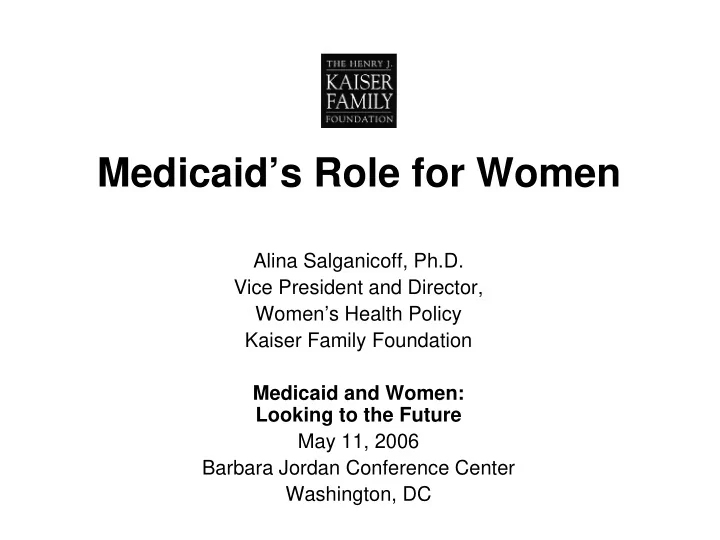

Medicaid’s Role for Women Alina Salganicoff, Ph.D. Vice President and Director, Women’s Health Policy Kaiser Family Foundation Medicaid and Women: Looking to the Future May 11, 2006 Barbara Jordan Conference Center Washington, DC
Figure 1 Medicaid is a critical health care safety net for millions of low-income women Women’s health insurance coverage, 2004 Low-Income Women All Women Uninsured Medicaid Uninsured 15% 7% Medicaid 28% 15% Medicaid and Employer- Medicare Employer- based / Other 3% 28% based / Other Medicare 58% Medicare 17% Medicaid and 23% Medicare 6% 41.3 Million 112.3 Million Note: Includes women ages 18 and older. Low-income defined as family incomes less than 200% of the federal poverty level ($31,340 for a family of three in 2004.) Source: Kaiser Family Foundation analysis of Urban Institute estimates based on March 2005 Current Population Survey, Census Bureau.
Figure 2 Women comprise the majority of adults on Medicaid Distribution of adult Medicaid enrollment, by sex and age, 2003 20% 27% 30% 33% 42% Men Women 80% 73% 70% 67% 58% Total 19 to 44 45 to 64 65 to 84 85 and older Source: Kaiser Commission on Medicaid and the Uninsured Analysis of 2003 MSIS data, 2006.
Figure 3 Most women on Medicaid are in their reproductive years Distribution of women ages 19 and older on Medicaid, 2003 65+ 22% 19 to 44 45 to 64 62% 16% Total = 19 million women Source: Kaiser Commission on Medicaid and the Uninsured, Analysis of 2003 MSIS Data, 2006.
Figure 4 Medicaid finances key services for women across the lifespan � Reproductive Years – Family planning & STD testing and treatment – Maternity care - prenatal and delivery; pays for 37% of U.S. births – Abortion very limited – Mental health � Mid-life – Disability - ICF/MR, rehabilitation, therapy, transportation – Chronic illness treatment and screenings – Breast and cervical cancer treatment option � Seniors – Nursing home stays – Home and community services - personal care, case management – Vision, dental, rehabilitation
Figure 5 Women on Medicaid are diverse Characteristics of non-elderly women on Medicaid, 2004: 6% Other* >200% FPL No children under 18% Hispanic 18 in household 21% 32% 100 to 199% FPL African- 27% American 24% 50 to 99% FPL Children under 28% 18 in household White 68% 49% <50% FPL 28% Poverty Status Race/Ethnicity Family Composition Note: Includes women on Medicaid ages 18 to 64. *Other consists of 4% Asian/Pacific Islander, 1% American Indian/Aleutian Eskimo, 1% multi-racial. The federal poverty level was $15,670 for a family of three in 2004. Source: Kaiser Family Foundation analysis of Urban Institute estimates based on March 2005 Current Population Survey, Census Bureau.
Figure 6 Women on Medicaid have considerable health needs Percentage of non-elderly women reporting they have been diagnosed with condition in past five years: 34% 12% Fair/Poor Health 21% 28% 16% Arthritis Medicaid 16% Private 13% Uninsured Diabetes 6% 8% 28% Asthma/Other 11% Respiratory Conditions 16% 40% 20% Anxiety/Depression 30% Note: Among women ages 18 to 64. *Significantly different from private, p<.05. Source: Henry J. Kaiser Family Foundation, Kaiser Women’s Health Survey , 2004.
Figure 7 Medicaid improves access to care for women Use of health care services, by type of insurance, 2004 10% No MD visit in 12% past year Medicaid 33% Private 11% No usual 7% Uninsured source of care 30% 27% No breast exam in past two 18% years 48% 16% No Pap test in 20% past two years 40% Note: Includes women ages 18 to 64. Source: Kaiser Family Foundation, 2004 Kaiser Women’s Health Survey .
Figure 8 Access to physician care can be challenging for women on Medicaid Percentage of non-elderly women reporting that in the past year they: * 33% * 28% Medicaid * 23% Private 18% Uninsured 13% 11% Tried to see a new doctor, Not able to see a specialist but doctor not accepting when thought one was needed new patients Note: Includes women ages 18 to 64. *Significantly different from Private, p<.05. Source: Kaiser Family Foundation, 2004 Kaiser Women’s Health Survey.
Figure 9 Cost can be a barrier to care for women on Medicaid Percentage of non-elderly women reporting that in the past year they: * 67% Medicaid Private Uninsured * 41% * 32% 19% 17% 17% Delayed care they thought Didn’t fill prescription was needed due to cost due to cost Note: Includes women ages 18 to 64. *Significantly different from Private, p<.05. Source: Kaiser Family Foundation, 2004 Kaiser Women’s Health Survey.
Figure 10 Over one-third of Medicaid spending is for long-term care Medicaid spending for services, 2004 Long-Term Acute Care Care 63% 37% Total = $270 billion SOURCE: Urban Institute Estimates based on data from HCFA/CMS Form 64 prepared for the Kaiser Commission on Medicaid and the Uninsured, 2005.
Figure 11 Women comprise the majority of long-term care population Nursing Home Residents Home Health Users Men Men 26% 35% Women Women 65% 74% Total = 1.5 million Total = 1.4 million Note: Nursing home residents refer to those ages 65 and older. Source: Health, United States, 2005 . Nursing home data from the 1999 National Nursing Home Survey. Home Health data from the 2000 National Home and Hospice Care Survey.
Recommend
More recommend